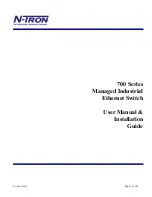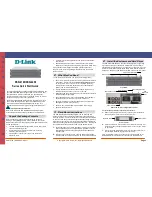
ESR-Series. User manual
16
•
•
•
2.2.3 Second-layer functions of OSI model
Table 3 lists second-layer functions and special aspects (OSI Layer 2).
Table 3 – Second-layer functions description (OSI Layer 2)
VLAN support
VLAN (Virtual Local Area Network) is a solution used for splitting a network into separate
segments on L2 level. VLAN utilization allows to increase the operation stability for large
networks by splitting them into smaller networks, isolate diversified data traffic by type and solve
many other tasks.
Routers support various VLAN management methods:
VLAN based on data packet tagging according to IEEE802.1Q
VLAN based on device ports (port-based)
VLAN based on utilization of data classification policies (policy-based)
Spanning Tree
Protocol
1
The main task of Spanning Tree Protocol is to exclude redundant network links and convert
network topology into the tree-like structure. Common areas of protocol application involve the
prevention of network traffic loops and establishing of redundant communication links.
1
In the current firmware version, this functionality is supported only by ESR-1000 router
2.2.4 Third-layer functions of OSI model
Table 4 lists third-layer functions (OSI Layer 3).
Table 4 – Third-layer functions description (OSI Layer 3)
Static IP routes
Administrator of the router can add or remove static entries into/from
the routing table.
Dynamic routing
With dynamic routing protocols, the device will be able to exchange the
routing information with neighbouring routers and automatically create a
routing table.
Router supports the following protocols: RIPv2, RIPng, OSPFv2, OSPFv3,
IS-IS, BGP.
ARP table
ARP
(Address Resolution Protocol) is a protocol used for resolution of
the network and data-link layer addresses. ARP table contains
information on the established correspondence.
Correspondence is established on the basis of the network device
response analysis; device addresses are requested with broadcast
packets.
DHCP client
DHCP (Dynamic Host Configuration Protocol) protocol enables
automation of the network device management process.
DHCP client allows the router to obtain the network address and
additional settings from the external DHCP server. As a rule, this method
is used for obtaining network settings of a public network operator
(WAN).
Содержание ESR Series
Страница 218: ...ESR Series User manual 218 ...
Страница 234: ...ESR Series User manual 234 In addition to RIP protocol configuration open UDP port 520 in the firewall ...
Страница 306: ...ESR Series User manual 306 Parameter targeted LDP Hold timer 45 seconds Keepalive holdtime 180 seconds ...
Страница 452: ...ESR Series User manual 452 Step Description Command Keys 4 Enable Tracking object esr config tracking enable ...
Страница 514: ...ESR Series User manual 514 esr show ntp peers ...
















































